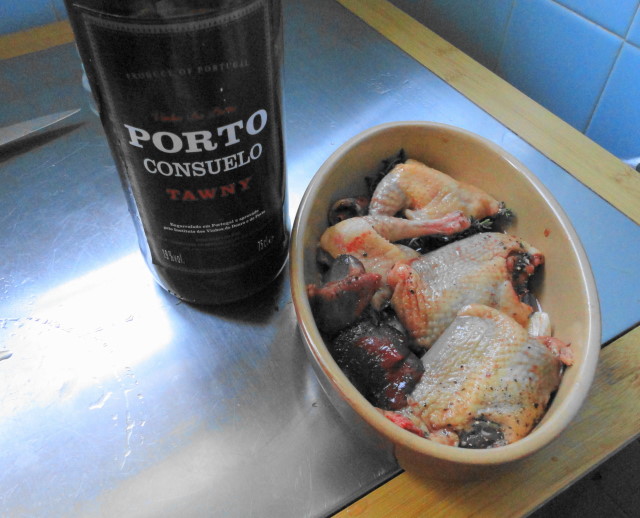
A quick supper dish that really was an inspiration du marché as the French say…an inspiration from a farm stand at the Sunday market at Amou, a short drive north of Orthez in the adjacent region of Les Landes Pigeon breast, legs, gizzard and heart, marinated with a bit of port wine, thyme and garlic, then pan roasted and served with a simple green salad.
I was a little surprised to find pigeon at the market in this part of France in April. That’s because pigeon, or more specifically its wild cousin the polombe is a fall specialty of the Béarn and the Pays Basque. These game birds are hunted in the deep mountain passes the Pyrenees each fall as they make their migratory journey south toward Spain and North Africa. Plump with the spoils of a warm season, these fat little birds are cooked in a variety of ways: Two of my favorites… roasted on a spit or en salmis. which mean the bird is roasted whole in a very hot oven until rare inside, then the carcass is crushed to provide the jus on whiche the red wine sauce for the final dish is based. The legs and breasts are then simmered in this sauce until done and the sauce is embellished with the crushed liver of the bird and sometimes also with its blood
I had an exemplary version of palombe en salmis last fall at a restaurant called Chez Mattin in Ciboure. This tiny basque restaurant, which is perched in the old town above the most important fishing port on the Cote Basque, was recommended to me by the owner of La Tupina, who lives in Ciboure and commutes to his restaurant in Bordeaux each day. Rich and earthy, this dish was deeply satisfying.
However, what was being offered by a wrinkled, slightly deaf countrywoman at Amou were pigeons raised on her farm, not wild doves. The palombes of the SW are a creamy buff-grey color, where as these pigeons had the grey coloring familiar from city parks around the world.
As the weather was hot, I decided to opt for a light, fresh preparation. First step: break down the bird, and separate out the parts to be cooked from those destined for the stock pot. Actually, in this case, the first step was emptying the bird, since the organ cavity was still intact, meany full still. Not a difficult process, but not one for the squeamish. The advantage of getting a bird that has not been emptied is that you know right away if it is fresh. A bird that has sat for a few days with its organs inside has a smell that leaves no doubt that it is not fresh. This particular specimen smelled pleasantly gamey, just what you would hope for.
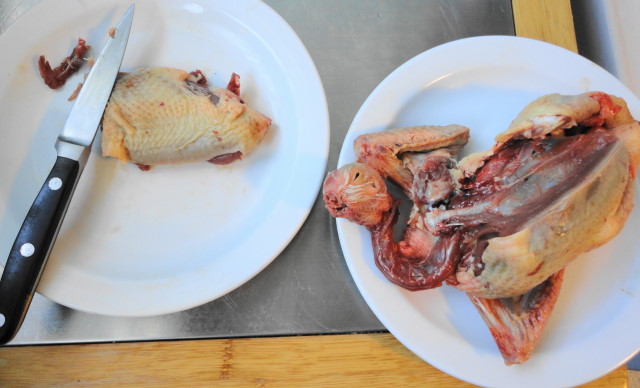
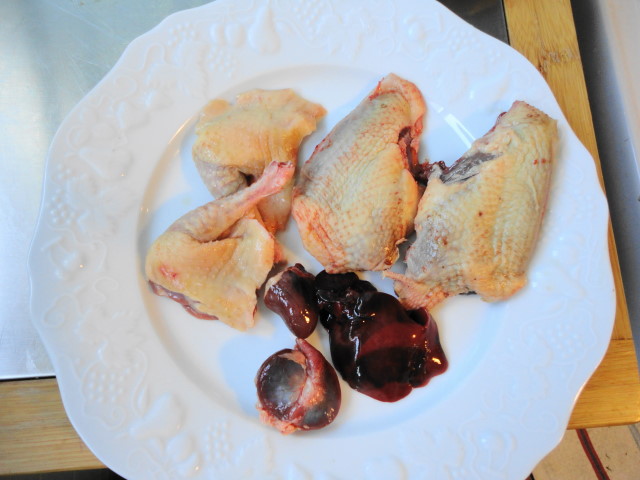
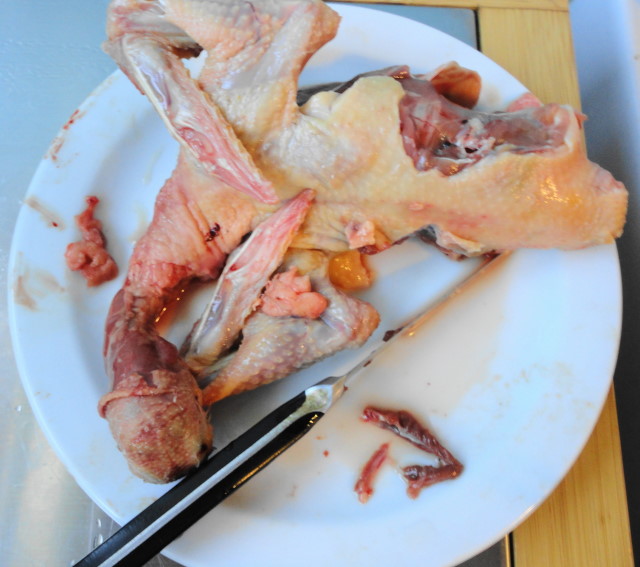
After cleaning and breaking down the pigeon, the parts to be roasted are put in a simple marinade for a few hours. In this case, I used a bit of garlic, some sprigs of thyme, port and walnut oil.

After marinating, the final cooking is easy. Starting with a fairly hot pan, add a small amount of fat: olive oil and butter mixed, or some duck fat or, if you happen to have left over foie gras fat (this is the southwest, remember; we had foie gras terrine mi cuit for aperitif), use that. When the fat is hot, add the pigeon pieces (which have been drained of marinade and seasoned with salt and pepper) skin side down and cook until the skin is nicely browned. Turn the pieces, and continue cooking while basting regularly with the pan fat.
Obviously some bits cook faster than others. The legs take the longest, the liver the shortest amount of time to cook. Put the legs in to cook first, then add the breasts, gizzard and heart a minute later and the liver just before the legs are done. I like my pigeon cooked so it is still very pink inside. The entire roasting process takes about 5 minutes
This bird had the mild gaminess and blood red colored meat that one would expect from a wild bird. Fantastic with the course red Madiran wine of the region where the pigeons were raised.
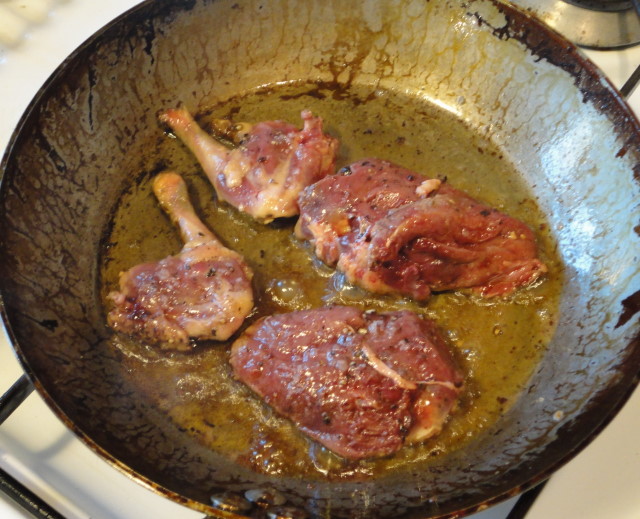
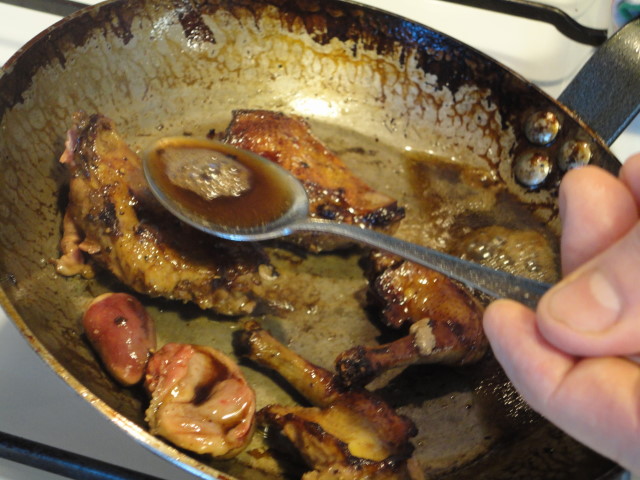
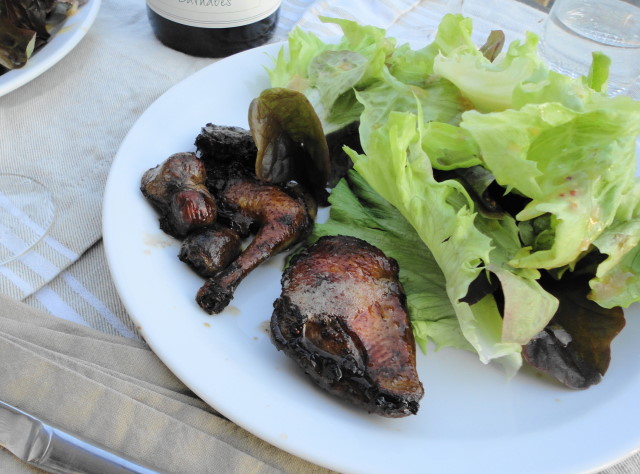
Jim-
We were in Le Pichet a few years ago when we journeyed to Seattle and were mesmerized by the atmosphere, the food and the feel of your gem. Your blog is great.
Thanks.
What a fantastic meal! I love hearing about the market-vendor, the seasonal nuances, etc… More, more!